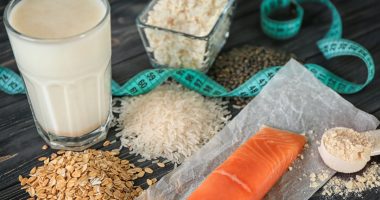“Eating nutrient-dense foods that are filled with fiber is important for fueling your body, however, there may come a time and place where fiber needs to be moderated,” says Laura Ligos, RDN, CSSD, a nutrition expert and recipe developer. Many people living with gastrointestinal diseases (such as Crohn’s or Ulcerative Colitis) may have to limit their fiber intake during flare-ups, and fiber is generally not recommended to anyone experiencing stomach discomfort as it isn’t the easiest to digest. “Of course, it’s necessary to have a conversation with a doctor to figure out the best diet for your condition,” adds Ligos.
Health benefits of fiber
Before we jump into low fiber fruits, let’s first outline what fiber is. There are two types of fiber: soluble and insoluble. The intestines can’t digest soluble fiber, so it binds to cholesterol and removes it from the body. Insoluble fiber helps add water into your stool, which makes it easier to poop because the softer texture puts less strain on your bowel. According to Ligos, it’s especially important to stay hydrated when eating foods with lots of fiber to (ahem) smooth out the process.
So how can you tell if you’re even getting the right amount of fiber? The Academy of Nutrition and Dietetics recommends that adults consume about 25 to 35 grams of total fiber per day, but the truth is, most people aren’t consuming nearly enough. The National Health and Nutrition Examination Survey (NHANES) data indicates that average US fiber consumption is 13 to 15 grams per day, which is approximately 50 percent of the current recommended intake.
Finding ways to incorporate more fiber into your diet is easier than you may think. Fiber can be found in a variety of fruits and vegetables such as pears and apples with the skin on, blackberries, artichokes, broccoli, brussels sprouts, and more. Many whole grains and legumes are also rich in fiber. These include, lentils, chickpeas, kidney beans, quinoa, and oats. And believe it or not, snacking on dark chocolate and popcorn can be another delicious way to increase your fiber intake.
When a low fiber diet can be beneficial
Just like with many other aspects of nutrition, everyone’s fiber requirements are different. For instance, a handful of health conditions, including gastroparesis and diverticulitis, can be better managed with a low fiber diet. Rebecca Ditkoff, MPH, RD, founder of Nutrition by RD, explains that “for people living with gastroparesis, their stomach empties too slowly, which can cause a range of symptoms—from mild to severe.” And, since eating too much fiber can delay gut transit time in the body, avoiding certain foods can help prevent additional issues, she adds.
“Diverticulitis is another condition where a doctor may suggest modifying fiber consumption,” says Ditkoff. It occurs when small pouches or pockets form in the wall or lining of the digestive tract. “Fiber recommendations for someone living with diverticulitis may vary. If you’re not in an active state of inflammation, also known as diverticulosis, you may require adequate fiber. Whereas if you’re in an acute state of inflammation, a doctor may tell you to eat a low fiber diet,” Ditkoff explains.
Additionally, irritable bowel syndrome (IBS) is a common GI condition where recommended fiber consumption varies depending on symptoms. Ditkoff suggests working with a doctor and a registered dietitian to get personalized support.
Low fiber fruits
Low fiber fruits are typically ones higher in water content, like watermelon. “Foods like applesauce, canned fruit, and fruit juices are also low fiber options,” Ligos explains. “Also, many juice drinks are higher in sugar, which may lead to different digestive and blood sugar issues depending on the individual.”
Here are 12 fruits that contain the least amount of fiber per serving (about 1 cup):
- Apricots (0.7 g)
- Plumbs (0.9 g)
- Cantaloupe (.9 g)
- Watermelon (1.1 g)
- Honeydew (1.1 g)
- Pineapple (1.2 g)
- Nectarines (2.2 g)
- Papaya (2.5 g)
- Banana (2.6 g)
- Strawberries (2.9 g)
- Raw figs (2.9 g)
- Peaches (3 g)
Whether you’re looking for fruits that are higher in fiber than the above or you’re (conversely) in search of a stomach-soothing snack—like fruit—that won’t irritate your gut, we wish you happy, healthy digesting.
ALSO READ: ‘Most stressful shift of my career:’ Stranded doctors help mudslide victims at B.C. hospital





